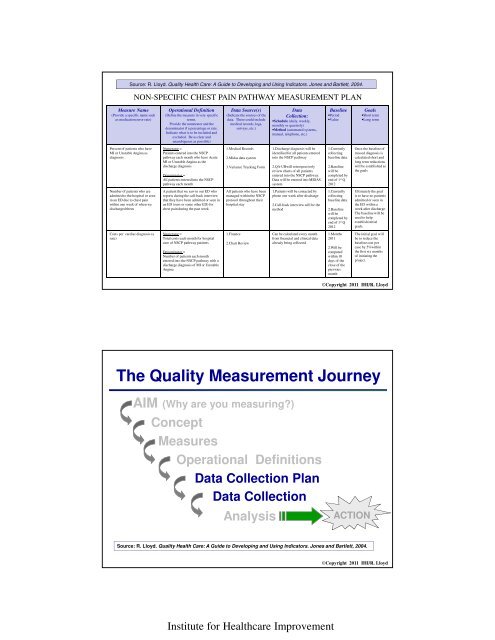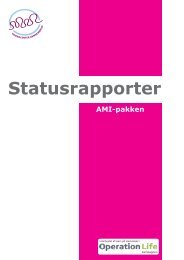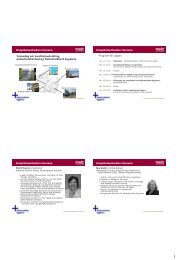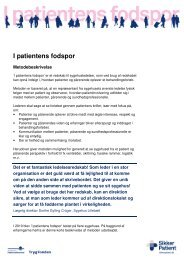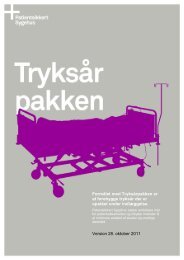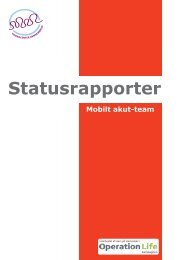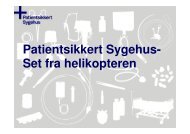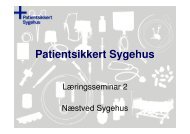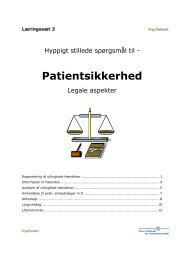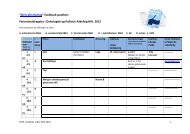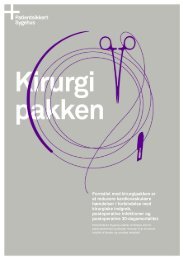The Quality Measurement Journey - Sikker Patient
The Quality Measurement Journey - Sikker Patient
The Quality Measurement Journey - Sikker Patient
Create successful ePaper yourself
Turn your PDF publications into a flip-book with our unique Google optimized e-Paper software.
Source: R. Lloyd. <strong>Quality</strong> Health Care: A Guide to Developing and Using Indicators. Jones and Bartlett, 2004.<br />
NON-SPECIFIC CHEST PAIN PATHWAY MEASUREMENT PLAN<br />
Measure Name<br />
(Provide a specific name such<br />
as medication error rate)<br />
Operational Definition<br />
(Define the measure in very specific<br />
terms.<br />
Provide the numerator and the<br />
denominator if a percentage or rate.<br />
Indicate what is to be included and<br />
excluded. Be as clear and<br />
unambiguous as possible)<br />
Data Source(s)<br />
(Indicate the sources of the<br />
data. <strong>The</strong>se could include<br />
medical records, logs,<br />
surveys, etc.)<br />
Data<br />
Collection:<br />
•Schedule (daily, weekly,<br />
monthly or quarterly)<br />
•Method (automated systems,<br />
manual, telephone, etc.)<br />
Baseline<br />
•Period<br />
•Value<br />
Goals<br />
•Short term<br />
•Long term<br />
Percent of patients who have<br />
MI or Unstable Angina as<br />
diagnosis<br />
Numerator =<br />
<strong>Patient</strong>s entered into the NSCP<br />
pathway each month who have Acute<br />
MI or Unstable Angina as the<br />
discharge diagnosis<br />
Denominator =<br />
All patients entered into the NSCP<br />
pathway each month<br />
1.Medical Records<br />
2.Midas data system<br />
3.Variance Tracking Form<br />
1.Discharge diagnosis will be<br />
identified for all patients entered<br />
into the NSCP pathway<br />
2.QA-URwill retrospectively<br />
review charts of all patients<br />
entered into the NSCP pathway.<br />
Data will be entered into MIDAS<br />
system<br />
1.Currently<br />
collecting<br />
baseline data.<br />
2.Baseline<br />
will be<br />
completed by<br />
end of 1 st Q<br />
2012<br />
Once the baseline of<br />
missed diagnosis is<br />
calculated short and<br />
long term reductions<br />
will be established as<br />
the goals<br />
Number of patients who are<br />
admitted to the hospital or seen<br />
in an ED due to chest pain<br />
within one week of when we<br />
discharged them<br />
A patient that we saw in our ED who<br />
reports during the call-back interview<br />
that they have been admitted or seen in<br />
an ED (ours or some other ED) for<br />
chest pain during the past week<br />
All patients who have been<br />
managed within the NSCP<br />
protocol throughout their<br />
hospital stay<br />
1.<strong>Patient</strong>s will be contacted by<br />
phone one week after discharge<br />
2.Call-back interview will be the<br />
method<br />
1.Currently<br />
collecting<br />
baseline data.<br />
2.Baseline<br />
will be<br />
completed by<br />
end of 1 st Q<br />
2012<br />
Ultimately the goal<br />
is to have no patients<br />
admitted or seen in<br />
the ED within a<br />
week after discharge.<br />
<strong>The</strong> baseline will be<br />
used to help<br />
establish initial<br />
goals.<br />
Costs per cardiac diagnosis (a<br />
rate)<br />
Numerator =<br />
Total costs each month for hospital<br />
care of NSCP pathway patients<br />
Denominator =<br />
Number of patients each month<br />
entered into the NSCP pathway with a<br />
discharge diagnosis of MI or Unstable<br />
Angina<br />
1.Finance<br />
2.Chart Review<br />
Can be calculated every month<br />
from financial and clinical data<br />
already being collected<br />
1.Months<br />
2011<br />
2.Will be<br />
computed<br />
within 10<br />
days of the<br />
close of the<br />
previous<br />
month<br />
<strong>The</strong> initial goal will<br />
be to reduce the<br />
baseline cost per<br />
case by 5%within<br />
the first six months<br />
of initiating the<br />
project.<br />
©Copyright 2011 IHI/R. Lloyd<br />
<strong>The</strong> <strong>Quality</strong> <strong>Measurement</strong> <strong>Journey</strong><br />
AIM (Why are you measuring)<br />
Concept<br />
Measures<br />
Operational Definitions<br />
Data Collection Plan<br />
Data Collection<br />
Analysis<br />
ACTION<br />
Source: R. Lloyd. <strong>Quality</strong> Health Care: A Guide to Developing and Using Indicators. Jones and Bartlett, 2004.<br />
©Copyright 2011 IHI/R. Lloyd<br />
Institute for Healthcare Improvement


